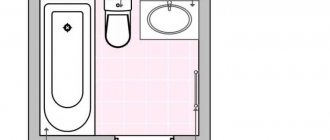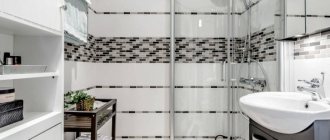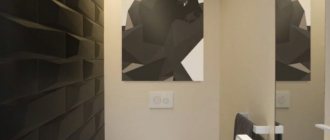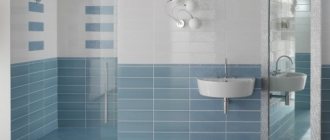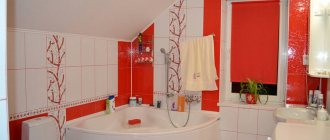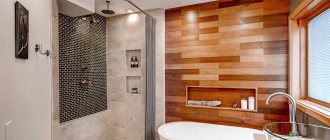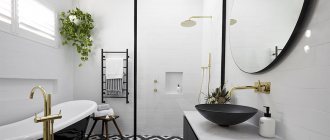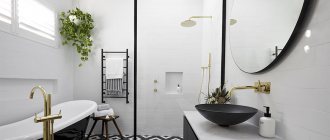What are the differences between wall-hung toilets?
At first glance, it may seem that a toilet mounted on the wall is a rather fragile and not very reliable device. But this impression is wrong, since thanks to its design, the toilet can withstand a weight of up to 400 kilograms.
The installation, or, more simply put, a specially made frame is the basis for the installation of wall-hung toilets. For reliability, the frame should be attached exclusively to concrete, brick or load-bearing walls, which ensures reliable fixation.
At the same time, all elements of the plumbing structure, including the flush cistern, are hidden from view, only the toilet bowl remains visible.
Important parts: cover and button
When choosing a toilet model, it is advisable to pay attention to the lid, which can be:
- traditional;
- having an automatic device that can lift the lid in a split second;
- equipped with a microlift system that ensures smooth lowering.
The latter function is useful in that it prevents mechanical damage to the lid when closing the toilet abruptly. Additionally, an antibacterial coating can be applied to the lid and seat to prevent the development of microorganisms.
A small but important detail is the flush button. It can be single or double, if different tank drain systems are provided (full and half, allowing you to save water).
Since the button is the only part of the fitting that is visible, manufacturers attach great importance to the design of this part. You can find buttons that have a wide range of colors: from traditional white to richly bright, from neutral to pearlescent metallic.
The flush button is a small but important element included with the wall-hung toilet. It has both functional and aesthetic significance
The large size of the buttons is due to the fact that an inspection window is hidden under them, allowing you to monitor and adjust the functioning of the shut-off valve and other fittings.
Main pros and cons
In addition to its compact size, which fits well into a room of any size, the main advantages of a wall-hung toilet include:
- modern look, which allows you to create an unusual design in the bathroom;
- reliable design that will last for many years;
- less noise when draining compared to standard models;
- Thanks to the wall mount, it simplifies wet cleaning in the bathroom;
- all pipes are securely closed from view behind a decorative panel;
- it is possible to install equipment equipped with additional functions, for example, a toilet with a bidet or special heating.
But, in addition to the positive aspects, when purchasing a wall-hung toilet set, you should not forget about the disadvantages of such designs:
- complex installation process, which requires special skills or hiring a specialist;
- in some cases it is necessary to redo the water supply systems;
- the flush tank requires the presence of free space in the wall, in the absence of which, a special recess will be required;
- closed access to the main elements of the toilet;
- relatively high cost compared to floor options.
Other classifiers
Wall-hung toilets can come in different sizes. Highlight:
- small-sized devices;
- medium-sized devices;
- large-sized devices.
When choosing the size of plumbing fixtures, you need to take into account the area of the bathroom. The toilet should not clutter it or interfere with the passage.
Also, this type of plumbing fixtures is usually divided into devices with and without a rim. According to most experts, the ideal option is a wall-hung rimless toilet. It has the following advantage - it does not accumulate rust or plaque, which makes it easier to care for. In addition, this design is considered more hygienic.It is necessary to say a few words about the wall-hung toilet with a microlift. Such a device significantly improves living conditions. It is more convenient for a person to visit the toilet if the toilet is equipped with a similar mechanism.
Wall-hung toilets can be designed in a variety of colors. White is considered standard. But on sale you can see products in black, red, beige and other shades. Also, quite often, manufacturers decorate their products with a variety of prints and ornaments.
Choosing a wall-hung toilet requires a serious approach. It is necessary to take into account many nuances and subtleties. If this is possible, you should consult an experienced plumber. It would be useful to study all the available information on specialized sites.
Remember that the price of a wall-hung toilet depends on many things - the presence of additional functions, material of manufacture, design solution, construction, manufacturer. Don't skimp on quality. Carefully consider your requirements for the device and only then go to the store.
Triton acrylic bathtubs - selection tips, location features and review of optimal modelsBidet mixer: 100 photos of modern models, recommendations for installation and selection of sizes
- Bathroom faucet - tips for choosing and the best ideas on how to choose the best model (100 photos)
Choosing a toilet
If the question of how to choose a wall-hung toilet is relevant to you, first you should familiarize yourself with all the main characteristics that you should pay attention to when choosing new plumbing fixtures.
Main characteristics of classic toilets
The classic type of toilet is a structure that is attached to the floor and behind which is a flush cistern. The main advantage of a classic-shaped toilet is that it can be mounted anywhere in the toilet room.
A classic toilet takes up approximately 50 cm more than any wall-hung structure, the cistern of which is built into the wall. Now there is a huge variety of design and style solutions for classic toilets, but in any case, the cistern is located outside - monolithic with the toilet, mounted on the wall, located nearby.
Bowl material and dimensions
A huge selection of materials allows you to purchase not only the usual porcelain or earthenware toilets, but also those made of stainless steel, plastic and even glass.
However, although photos of a wall-hung toilet made of such unusual materials attract attention, steel and glass are rarely used at home or in an apartment due to their impracticality and high cost.
Classic versions of porcelain or earthenware bowls have a smooth surface, are easy to use and last a long time.
Modern toilets differ not only in the materials from which they are made, but also in size:
- small or compact, ideal for a small bathroom or toilet;
- medium size, are one of the most common options;
- enlarged, installed for people with physical problems or in the case of a large bathroom area.
Advantages
- This toilet is perfect for small rooms, since the installation is hidden in the wall, and only wall-hung plumbing remains outside - this will increase the area of free space.
- It is possible to hide all communications.
- Cleaning the bathroom becomes much easier, since there is no foot, which usually creates hard-to-reach places where a lot of dirt and dust accumulate.
- Very reliable models, as a rule, can withstand up to 400 kg.
- Virtually indestructible.
- The installed toilet has a double silent flush mechanism.
- There are various models of toilets with installation, for example those that are attached simultaneously to the wall and the floor (this allows you to fix the toilet even to a plasterboard wall).
- Possibility of adjusting the height of the toilet due to special rods attached to the steel frame.
Photo: paguponhome.com
Flush system
First of all, automatic and standard flush control should be highlighted. Unlike the more common manual flush, automatic flushing occurs after a special signal from installed sensors.
In addition, flushing systems are divided into two types:
- horizontal, when water is supplied around the bowl and then goes down the drain;
- circular, with water supplied from inclined holes in the toilet bowl in a spiral.
Myths about installation
Among consumers, and some specialists, there are several statements that are difficult to agree with.
- A classic toilet can withstand greater mechanical loads than a wall-hung one. In fact, a compact toilet is designed for a weight of 200 kg, a wall-hung one - for a static load of 600 kg (per bowl - 400 kg).
- It is difficult to repair the drain system due to the small hole for the tank control panel. The manufacturers took this point into account and placed all the fittings in the panel area (see photo).
Drain control circuit.
Despite the small size of the panel, access to the cistern fittings is excellent.
- It is difficult, if not impossible, to repair communications. An invisible hatch will help here, through which access to all fittings and water meters is provided. The likelihood that the pipe itself will leak, resulting in it having to be replaced, is very low.
Shape and color of the toilet
Most often, when choosing a new toilet, buyers choose the usual white color, which will harmoniously fit into any interior.
But, if the bathroom design allows you to experiment, the shades can be different, even the most unusual. Photos of wall-hung toilets in the interior will help you choose the right color shades to match your bathroom design and make your choice.
The shapes of toilets found on sale also leave room for imagination. The bowl can be either oval or round, or square and even with beveled corners. However, when choosing a shape, you should remember that round-shaped toilets, without corners and depressions, are much easier and more convenient to clean.
Sitz baths that can be installed in a small bathroomConnecting an automatic washing machine without running water in a country house or village
Review of pumping stations for water supply at home: connection diagrams and installation rules
Or maybe a bidet?
You can always purchase a bidet to pair with the toilet, if space allows and you want to diversify the interior of the toilet room. The bidet is installed next to the toilet. It has its obvious advantages when carrying out hygiene procedures. Today, bidets have a number of useful functions: adjustable water pressure, an automatic lid mechanism, a warm air drying system, a so-called “hair dryer,” water massage, and remote control.
To decide which wall-hung toilet is best to purchase, you need to decide on the main selection criteria: familiarize yourself in detail with the technical characteristics of a particular model, choose the color and shape of the bowl. And, of course, weigh the cost of the purchase against your financial capabilities. Then this essential element of the bathroom will delight its owners for many years with its impeccable performance.
What is better to choose
So, what should a buyer choose? Which is better – a wall-hung toilet or a floor-standing one? More than 90% of European households choose hanging installations. More expensive models pay for themselves due to significant savings on water. The long service life of such products will allow you to forget about the need to replace the toilet for a long time. In addition, the installations are compact, look great in any interior and are convenient for maintaining order in the room.
But the cost of installations, despite all the advantages, often becomes an obstacle for a potential buyer, especially in our country. If you lack funds, you should give preference to classic floor models.
When calculating costs, you also need to take into account the cost of installing the system. You can install the classic model yourself, but you will have to pay a decent amount for installation. When choosing a model, you need to proceed from the design features of the room. If the walls are made of plasterboard, installation of the installation is impossible; you will have to be content with the classics.
Taking into account all the structural features of the room and design features, the buyer can easily choose exactly the toilet that is best suited for the existing conditions.
Dimensional range of toilet installations
When choosing an installation, you need to pay attention to its parameters. This is especially important if a specific space has already been allocated for installation of the system.
The standard version of block systems has the following dimensions:
- width – 50 cm;
- depth – 10-15 cm;
- height – 1 m.
A typical frame structure usually has the following parameters:
- width – 50-60 cm;
- depth – 15-30 cm;
- height – 0.8-1.4 m.
When choosing frame installations for placing plumbing under a window, it is better to give preference to lower modifications with a height of 80-82 cm. Low, wide structures that reduce the load on the walls are preferably used in houses with wooden partitions.
To better meet customer needs, many companies produce non-standard modifications of models.
The assortment of the German company TESE includes an installation with a depth of only 8 centimeters. A slightly wider version of 9 cm is produced by the Spanish manufacturer Roca .
A miniature design with a width of 30 cm is offered by the Italian company Migliore , and in the size range of the Dutch company WiSA Excellent there is an option with a similar parameter of 38 cm.
Features of frame installations
This is an assembled steel frame that allows you to attach it in a variety of ways. Installation of this design can be performed in any type of premises. Most often you can find models on sale that are installed on four fulcrum points. It is advisable to attach them to a load-bearing wall. That’s why it’s called a frame with wall fasteners. There are models that are fixed to the floor using special elements.
These frames have become very popular recently. For them, overall dimensions and installation location are not so important. The frame can be fixed exactly where the owner needs it. Since the wall does not always have the necessary strength, the presence of floor fasteners will help.
In compact bathrooms, many people install corner built-in toilets - as a result, you can gain a lot of free space.

